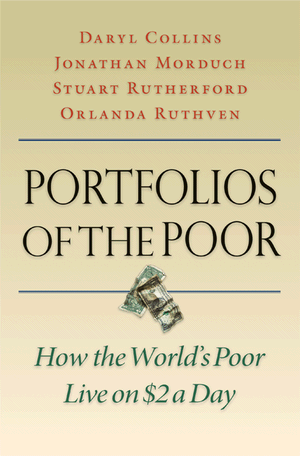 The topic below was originally posted on my blog, the Intrepid Liberal Journal.
The topic below was originally posted on my blog, the Intrepid Liberal Journal.
According to the World Bank, almost forty percent of humanity lives on a daily income of less than two dollars per day. Another 1.1 billion scrape by on less than one dollar per day.
How can anyone possibly survive or raise a family with such a meager income? In New York City, two dollars per day won’t even cover my daily Brooklyn/Manhattan round-trip subway commute. Yet billions of low skilled people put food on the table, educate their children, grapple with unexpected emergencies and even save money.
In Portfolios of the Poor: How the World’s Poor Live On $2 a Day, Darryl Collins, Jonathan Morduch, Stuart Rutherford and Orlanda Ruthven, compiled yearlong “financial diaries,” of villagers and slum dwellers in Bangladesh, India and South Africa. The diaries track penny by penny, how specific households manage their money with sophistication and resourcefulness. Recently published by Princeton University Press, Portfolios of the Poor, presents revealing data in an accessible seven chapters and 184 pages of text. The text is supported with an additional eighty plus pages of appendices, data tables and notes illustrating “the story behind the portfolios.”
In a tour de force of primary research, the authors report that the world’s poorest do not live hand to mouth and desperately spend what they earn just to keep from drowning. Instead, they utilize financial tools, rely on “informal” networks through relatives and neighbors and navigate perils such as medical calamities and political strife. Their stories are both inspiring as well as heartbreaking.
Although the world’s poorest are far more adept at financial management then previously understood, they’re confronted with what the authors describe as the “triple whammy”:
1. Low income.
2. Irregularity of income.
3. Unpredictability about when they will earn income.
Hence, the authors assertively advocate for microfinancing as a means of empowering the world’s poorest with more secure and convenient instruments to access and manage money. Microfinancing is financial services for low income clients in the world’s poorest countries who are self-employed or operating their own businesses.
The authors argue in their book that microfinancing should also be extended to address the needs of exceptionally low-income wage earners as well. It is their contention that poor people in the countries they researched demonstrate on a daily basis that they are responsible money managers and would also be reliable clients of microfinancing services.
One of the authors, Jonathan Morduch, is a New York University (“NYU”) professor of economics as well as a managing director of the Financial Access Initiative – a consortium of researchers at NYU, Harvard, Yale, and Innovations for Poverty Action. Morduch, agreed to a telephone podcast interview with me about the book and our conversation was just under twenty-six minutes.
Among the topics covered was how his team earned the confidence of the people interviewed, the informal market tools utilized by the world’s poorest in Bangladesh, India and South Africa and why he’s a proponent of extending microfinancing to the world’s poorest wage earners.
Please refer to the flash media player below.
This interview can also be accessed at no cost via the Itunes Store by searching for either the “Intrepid Liberal Journal” or “Robert Ellman.
1 comment